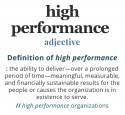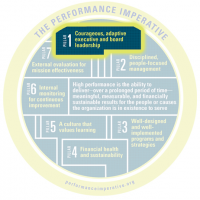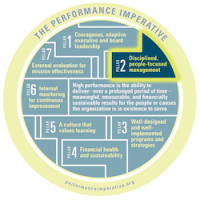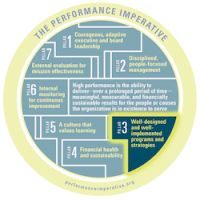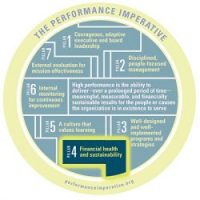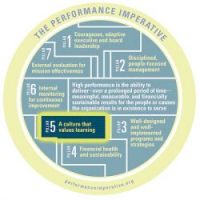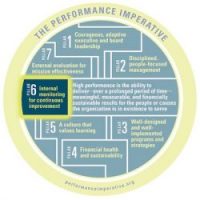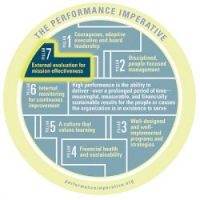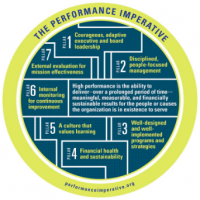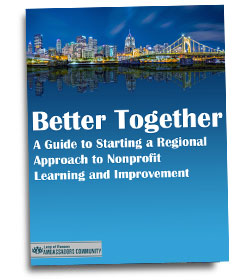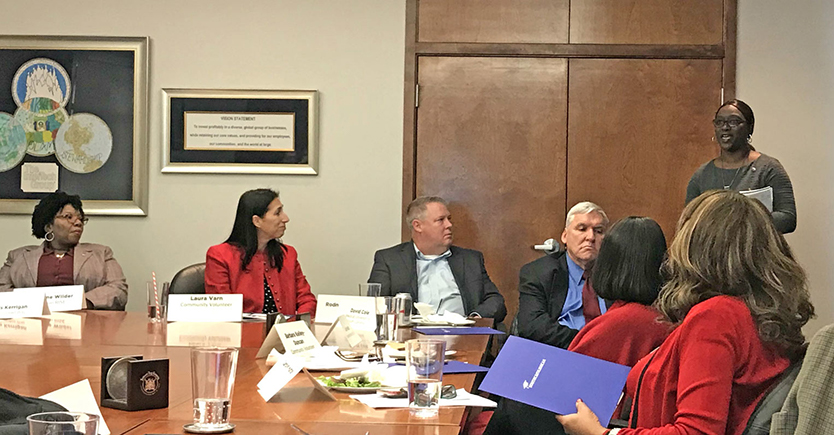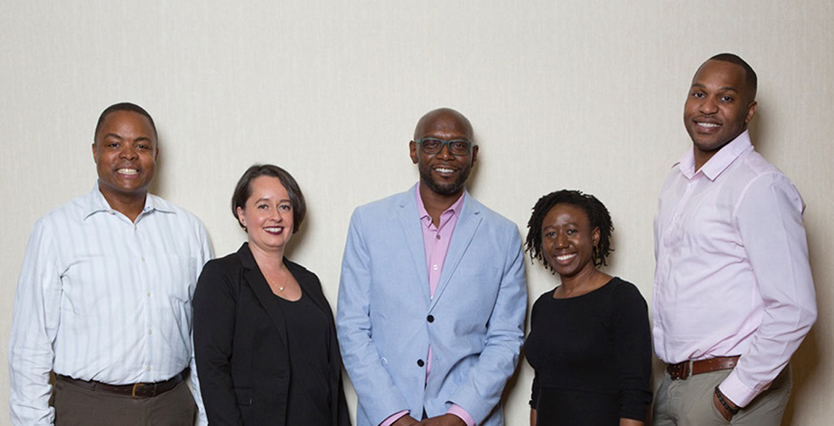The Pittsburgh Learning Circles Program Model
The Pittsburgh Learning Circles Program brought together nonprofit leaders, mentors/facilitators, coaches/executives-in-residence, and funders—all eager to strengthen regional nonprofits and leadership. Twenty-six participants met in both large groups for a speaker series and smaller learning circles of approximately eight participants and their mentors/facilitators. The speaker series included topics such as leadership, theory of change, CEO and board partnerships, and organizational culture.
This program gave me an opportunity to take an objective look at the organization and I now see it differently than I saw it absent the program.
—Program Participant
Cohort participants in the learning circles used resources from the Leap Ambassadors Community Continuous Improvement Pathway, including the Performance Practice to dive deeper into the definition and disciplines of high performance from the Performance Imperative and apply it for ongoing reflection, learning, and continuous improvement in their own organizations. As part of the process, participants developed organizational improvement plans to highlight a specific focus area for improvement identified during the Performance Practice review. Cohort members also discussed common challenges and provided support and ideas for potential solutions in their peer-learning circles.
Success Factors
A regional approach to learning and improvement can be innovative, collaborative, and effective. Here are critical elements that Pittsburgh leaders suggest you have in place for success in your region:
- An Ecosystem With a Commitment to Learning and Improvement — Find local leaders who believe in, value, and support continuous improvement efforts that lead to high performance. These leaders need to have worked collaboratively in the past or have the appetite to do so.
- Strong Infrastructure — Identify an anchor institution (for example, The Forbes Funds, a national organization with regional chapters or units) with credibility, capacity, and strong relationships with funders and stakeholder nonprofits.
- Funding Support — Establish a budget (The Forbes Funds found the project expenses of approximately $100K to be low cost and high impact). Identify a lead funder willing to engage other funders to gain buy-in and financial support.
- A Framework for Organizational Learning and Improvement — Complimentary materials from the Leap Ambassadors Community are a guide for the program and an ongoing resource for individual nonprofits. The Performance Imperative provides a shared definition of high performance and a framework of seven organizational disciplines with underlying principles to explain what it takes to achieve high performance.For each of the Performance Imperative’s principles, the Performance Practice presents one or more specific practices or behaviors that represent manifestations of that principle in action. The Performance Practice gave participants an extensive, in-depth look into their organizations and a broad lens to identify areas for improvement.
- Experienced, Local Mentors/Facilitators — Involve experienced nonprofit executives with credibility in the community and a personal commitment to continuous improvement toward high performance. Executives should also have good group facilitation skills and the ability to connect and engage leaders. One Pittsburgh learning circle had two strong female mentors, resulting in an unintended positive benefit. For example, the mentors gave insights and sound advice on navigating gender bias in the workplace.Mentors/facilitators should use the Performance Practice in their own organizations before the beginning of the learning circles to guide cohort participants in effectively using the resource for continuous improvement.
- Aligned Participants — Define your target population (for example, by geography, budget size, or affinity). Nonprofit leaders who have a commitment to continuous improvement will benefit the most. Each organization should send two participants, one of whom should be the CEO or another executive-level decision maker since the process should trigger organizational changes. Two participants from each organization ensures knowledge transfer back to the organization. When non-decision-makers were the only organizational representatives, they weren’t as able to drive organizational changes.
Program Logistics
Based on their pilot experiences, Pittsburgh leaders suggest some important logistical issues to consider.
- Choose appropriate topics for the learning circles in your region. The pilot cohorts focused on three of the Performance Practice modules: Disciplined, people-focused management; well-designed and well-implemented programs and strategies; and financial health and sustainability. NOTE: Almost three-quarters of pilot participants asked to participate in the financial sustainability learning circle. If there is great interest in one area, consider offering more than one learning circle for that module.
- Define the program schedule. We recommend designing a schedule that includes a half-day orientation session, monthly peer-learning circle sessions, and a final presentation by each learning circle with the full group. You might also consider bringing the full group together to hear speakers discuss topics related to high performance. To maintain momentum, Pittsburgh leaders recommend that these full-group sessions not interrupt the flow of the monthly peer-learning circles.
- Determine make-up of learning circles. Ideally, learning circles should be no larger than eight participants. The Pittsburgh pilot mixed smaller and larger organizations in learning circles. However, some participants reported that it hampered some conversations and learning. For example, one discussion about personnel problems presented solutions involving HR and legal departments—which smaller organizations don’t have. Other participants noted they found it helpful to hear from organizations with larger budgets and discover different ways to address problems. You may want to be mindful of dimensions like organizational size during the enrollment process to find the best groupings for your project and/or be mindful of the need to address issues from multiple viewpoints.
- Schedule comprehensive training sessions (View outline, PDF). Provide monitoring guidance and mentor/facilitator reports (view sample report, PDF) and a checklist for mentors/participants (view sample checklist, PDF). Facilitation guides should include clear expectations of the work to be done, a project timeline with deadlines, a checklist, suggestions for data analysis, and materials/outputs needed for each session. If coaches/executives-in-residence are a component of the program (see story here), distinguish between the roles of facilitators/mentors and coaches and how each role supports participants. NOTE: The Leap support team provided resources and support to partner with The Forbes Funds to establish the first regional pilot as a model for other regions. See helpful materials in the Appendix and feel free to contact the support team for general advice and questions.
- Plan an in-depth orientation session for participants. Plan a half-day orientation session (view sample agenda, PDF) to launch the program. Provide materials, allow for introductions, and set clear expectations for program participation.
- Implement ongoing performance monitoring and internal evaluation. Monthly reports from the mentors/facilitators should include topics discussed, challenges or obstacles presented, use of coaches (if available), and progress on each organization’s improvement plan. Timely reporting allows for course correction. Use our Monitoring Checklist for Anchor Organizations (PDF file) to make sure you discover problems while there’s still time to course-correct. The midway and final participant evaluations are equally critical for determining project benefits.
- Plan for assessment of longer-term results. At the outset, participants should agree to provide feedback one year after completing the program to share progress from their organizational improvement plans created during the program. Organizational improvements often take longer to materialize than the length of the program so ongoing communication is key for capturing longer-term results.
- Structured format. Mentors/facilitators and participants found that more structure within the group yields richer discussions and learning. Homework assignments helped them prepare for the next group session and keep the learning objectives front and center in their everyday work.
Key Program Takeaways from Nonprofit Leaders and Mentors
Participants found these benefits from the peer-learning circles project component:
Connections, support, and learning. Knowing that other leaders have similar problems and challenges helped break down isolation that executives often feel. A foundation of trust in the learning circles allowed them to air hardships and provide validation to each other. Participants indicated they learned a lot from each other and valued the opportunity to talk openly about organizational challenges and problems in a highly confidential space. These connections also present ongoing opportunities for collaboration on common issues.
Mentors and nonprofit leaders offered different experiences, perspectives, and viewpoints on common challenges and possible solutions. For example, participants didn’t expect a discussion on the importance of self-care, how it helps them and their employees, and ways to integrate self-care in their busy lives for their own performance and continuous improvement. The affirmation of a common problem, along with the ideas and suggestions to take care of themselves, helped them to be more aware and set a path forward.
I am encouraged by the work we are doing through the Performance Practice as it helps give me perspective and real-time lessons for how to tackle the work. I am also excited about some of the recent changes made that are leading us in the right direction.
—Program Participant
Value of local expertise. Nonprofit leaders found the openness of the mentors, their willingness to share challenges they had faced, and their problem-solving methodologies helpful. Mentors also found participation to be a personal growth experience.
The continuous improvement pathway materials. The Performance Imperative and Performance Practice provided a common definition of high performance and a shared language to discuss organizational improvement. As a valuable resource collaboratively developed by 50+ nonprofit practitioners, researchers, funders, and consultants, the Performance Practice helped leaders focus and learn from staff feedback, while peers and mentors offered valued support and perspective. Participants identified other benefits, including:
- A shift from reactive to proactive. The process, based on the structured approach provided by the Performance Practice, reinforced the value of assessing critical organizational areas for a better grasp of strengths and improvement topics. Participants were able to move from a reactive to proactive stance in their work.
- An effective way to engage board and staff. Leaders were better able to understand what was most important to their board and staff. Board and staff got a better grasp of the organization’s overarching work for greater alignment.
- A vehicle for important discussions. Participants found that the results from the organizational self-assessment were a good way to start necessary (and often difficult) conversations. The ability to cite the data and feedback from staff in response to the proof points was an objective way to begin tough conversations.
- A way to prioritize. It’s often overwhelming to prioritize improvement areas when there’s so much work to do. Participants indicated that completing the Performance Practice, evaluating the results, and creating themes from the feedback helped them determine where to begin.
- A focus on getting better at getting better. Participants found the continuous improvement resources were a valuable guide that emphasizes improvement rather than perfection. It helped focus their attention on the most important areas of improvement for their individual organizations at the current time.
- An avenue for buy-in. Leaders found what they learned through their participation helped get buy-in for necessary changes because 1) it involved input from people throughout the organization, and 2) the improvement plan was based on data from the group and developed during/after a process of joint reflection.
- A resource for optimism and hope. Staff expressed hope after discussing organizational strengths and weaknesses. The goal of providing high-quality services resonated especially with frontline staff. It seemed to provide greater clarity on where the organizations stood on the path to serve clients better.
Post-Pilot Notable Achievements
It got everyone on the same page as to what the goal was and how it was going to be accomplished.
—Program Participant
Although the pilot ended in December 2018, examples from program participants indicate the beginning of organizational changes and improvements.
One organization realized they had strong logic models for specific programs but lacked an overall organizational theory of change. The board strategic planning committee members and designated staff began the process of creating a draft in preparation for a strategic planning effort.
Another organization needed a more strategic way to assess its programs’ ongoing value in support of mission. As a result of tools shared by a mentor, this organization made changes: Of 11 programs, they decided to increase their investment in four, maintain five, and phase out two. Although profitable, the two programs phased out weren’t core to mission and overlapped with programs at other organizations. Discontinuing two profitable programs was a difficult decision, but leaders knew it was the right thing to do—an equally great example of the Performance Imperative’s Courageous Leadership discipline.
One organization’s completion of the well-designed and well-implemented programs and strategies module uncovered a major flaw in its feedback collection process. The staff person who provided services and built relationships with clients also conducted the verbal evaluations. This process raised a number of questions: “How honest were the clients since they were giving feedback to the person providing services? Was there bias in the evaluation write-ups?” They reviewed their data collection practice, other options, and the feasibility of others assisting with client feedback and data collection. As a result, a more objective person who doesn’t provide services now collects client feedback data.
One leader looked at the financial sustainability of each program and the organization as a whole, realized the organization needed to diversify its funding streams, and decided to leverage relationships for corporate funding. The peer-learning circle provided helpful feedback on a corporate sponsorship packet which included a menu of support options. The organization has seen some initial success in corporate sponsorship to help diversify its funding for greater financial sustainability.
